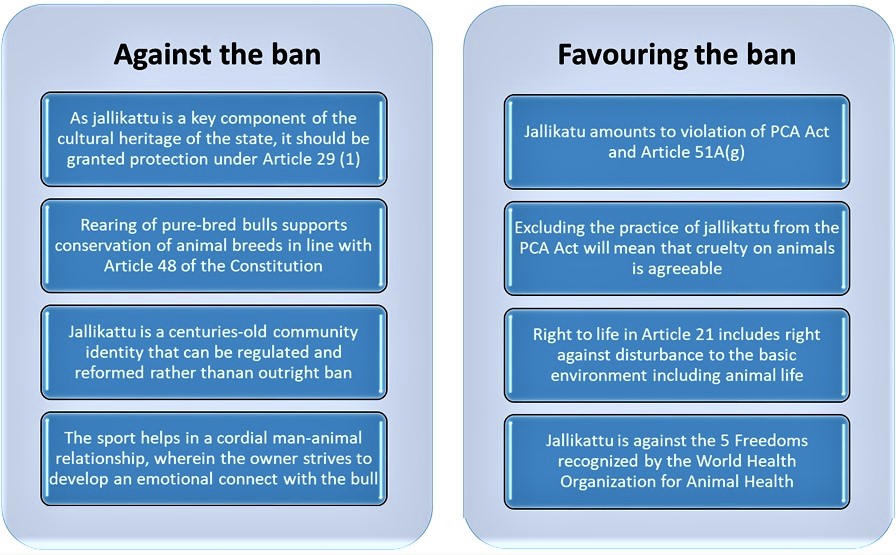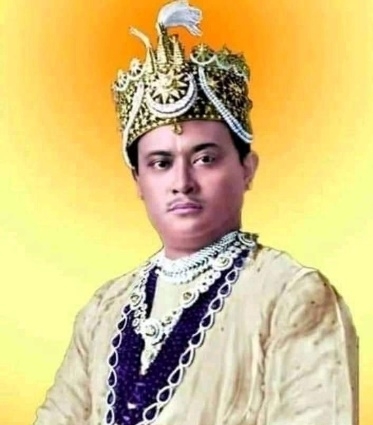- Home
- Prelims
- Mains
- Current Affairs
- Study Materials
- Test Series
 EDITORIALS & ARTICLES
EDITORIALS & ARTICLES
August 20 , 2024 Current Affairs
Jallikattu
Lure of easy money keeps Kuppam ‘Jallikattu’ going
About Jallikattu:
- Jallikattu (or sallikkattu) is also known as eru thazhuvuthal and mañcuvirattu.
- The bull-taming sport is popular in Madurai, Tiruchirappalli, Theni, Pudukkottai and Dindigul districts — known as the Jallikattu belt.
- A tradition over 2,000 years old, Jallikattu is a competitive sport as well as an event to honour bull owners who rear them for mating.
- It is a traditional sport in which contestants try to tame a bull for a prize; if they fail, the bull owner wins the prize.
- Jallikattu is considered a traditional way for the peasant community to preserve their pure-breed native bulls.
- Kangayam, Pulikulam, Umbalachery, Barugur and Malai Maaduare among the popular native cattle breeds used for Jallikattu.
The Associated Concerns
- The primary question involved was whether Jallikattushould be granted constitutional protection as a collective cultural right under Article 29 (1).
- Article 29 (1) is a fundamental right guaranteed under Part III of the Constitution to protect the educational and cultural rights of citizens.
- The court examined if the laws “perpetuate cruelty to animals” or were actually a means to ensure “the survival and well-being of the native breed of bulls”.
- The five-judge Benchheard parties on whether the new Jallikattu laws were “relatable” to Article 48 of the Constitution, which urged the state to endeavour to organize agriculture and animal husbandry on modern and scientific lines.
- The Constitution Bench also looked into whether Jallikattu and bullock-cartraces laws of Karnataka and Maharashtra would actually sub-serve the objective of “prevention” of cruelty to animals under the Prevention of Cruelty to Animals Act of 1960.
The Associated Legal Interventions
- In 2011, the Centre added bulls to the list of animals whosetraining and exhibition is prohibited.
- TheSupreme Court banned Jallikattu through a judgment in May 2014 in the Animal Welfare Board of India vs A. Nagaraja case on the grounds of cruelty to animals.
- In 2018, theSupreme Court referred the Jallikattu case to a Constitution Bench, where it is pending now.
- The bone of contention is the Prevention of Cruelty to Animals (Tamil Nadu Amendment) Act of 2017 and Prevention of Cruelty to Animals (Conduct of Jallikattu) Rules of 2017, which had re-openedthe gates for the conduct of the popular bull-taming sport in the name of culture and tradition despite a 2014 ban by the Supreme Court.
Argument for and against the ban of Jallikattu

Clean Ganga mission head flags slow pace of projects
Key Highlights:
- Program: National Mission for Clean Ganga (NMCG)
- Total Sanctioned Funding: ₹37,550 crore
- Amount Spent (as of June 2024): ₹18,033 crore
- Sewage Infrastructure Projects Funding: ₹15,039 crore
- Expenditure Issue: Slow pace, especially in Uttar Pradesh
- Uttar Pradesh Spending: ₹15.16 crore spent on six projects; ₹25 crore pending
National Mission for Clean Ganga (NMCG):
- It is a registered society under the Ministry of Jal Shakti, Government of India, to take measures for prevention, control, and abatement of environmental pollution in the river Ganga and to ensure continuous adequate flow of water so as to rejuvenate the river Ganga.
- It acted as the implementation arm of the National Ganga River Basin Authority (NGRBA), which was constituted under the provisions of the Environment (Protection) Act (EPA), 1986.
- NGRBA has since been dissolved with effect from 7th October 2016, consequent to the constitution of the National Council for Rejuvenation, Protection, and Management of River Ganga (referred to as National Ganga Council).
Objectives of NMCG:
- To ensure effective abatement of pollution and rejuvenation of the river Ganga by adopting a river basin approach to promote inter-sectoral co-ordination for comprehensive planning and management and
- To maintain minimum ecological flows in the river Ganga with the aim of ensuring water quality and environmentally sustainable development.
Structure:
- NMCG has a two-tier management structure that comprises of Governing Council and Executive Committee. Both of them are headed by Director General, NMCG.
- The Executive Committee has been authorized to accord approval for all projects up to Rs.1000 crores.
- Similar to the structure at national level, State Programme Management Groups (SPMGs) acts as the implementing arm of State Ganga Committees.
- The Director General (DG) of NMCG is an Additional Secretary in Government of India.
Challenges Faced by NMCG
Land Acquisition:
- Several plants took time to be commissioned asthere were problems with land acquisition.
- In many instances, the Detailed Project Reports (which prescribe all the steps necessary to execute a project, and the roles of agencies) needed revision.
Lack of Local Initiatives:
- State Governments are under the impression that building treatment plants was entirely the Centre’s responsibility.
- Waste management, especially MSW segregation and recycling, is most effective when handled at the source.
- While there were plans to create a cadre of village and town-level volunteers to monitor water quality and support local bodies, the mission has faced challenges in effectively implementing these initiatives.
Inadequate Sewerage Coverage:
- Much of India''s urban population resides outside sewerage networks, resulting in a substantial portion of waste not reaching STPs.
Improper Waste Disposal:
- The study by the Quality Council of India revealed that rubbish heaps are found near Ghats in numerous towns along the river, indicating improper waste disposal practices. This poses a threat to the cleanliness of the Ganga.
Thalassemia Bal Sewa Yojana reaches successfully completes 500 bone marrow transplants
Key Highlights:
- Bone Marrow Transplants Completed: 500.
- Financial Assistance: Up to ₹10 lakh per patient.
- Eligibility: Families with annual income below ₹8 lakh.
- Launched: 2017.
Thalassemia Bal Sewa Yojana
About the scheme:
- Launched in 2017, this scheme is a Coal India CSR funded Hematopoietic Stem Cell Transplantation (HSCT) program.
- It aims to provide a one-time cure opportunity for Haemoglobinopathies like Thalassaemia and Sickle Cell Disease for patients who have a matched family donor.
Eligibility:
- Only patients whose monthly family income is below Rs 20,000will be eligible for this assistance.
- The scheme has been extended to cover Aplastic Anaemia patients(lack of blood cell production in body).
Statistics:
- It is estimated 10,000 to 12,000 children are born with thalassemia every year in India.
- Data on the prevalence of silent carriers(persons without symptoms but potential to transmit to offsprings) for various Haemoglobinopathies show that silent carriers are 9-4.6% for Thalassemia, while it can be as high as 40% for sickle cell anaemia especially among the tribal population.
About Thalassemia
- Thalassemia is a chronic blood disorder. A person with this genetic condition cannot produce enough hemoglobin, which is found in red blood cells (RBCs).
- Patients also need blood transfusions every two to three weeks to survive as a result of this, which causes anemia.
- Thalassemias are conditions that are passed down through genes from one generation to the next.
Sickle Cell Disease
- It is an inherited disease caused by defects, called mutations, in the beta globin gene that helps make hemoglobin. The red blood cells become hard and sticky and look like a C-shaped farm tool called a “sickle”. The sickle cells die early, which causes a constant shortage of red blood cells.
PM Modi greets citizens on occasion of World Sanskrit Day
- World Sanskrit Day, also known as International Sanskrit Day, Sanskrit Diwas, and Vishwa Samskrita Dinam, is observed on the day of Shravana Poornima in the Hindu calendar.
- The primary objective of this day is to increase awareness and promote Sanskrit, one of India’s most ancient languages
World Sanskrit Day Theme 2024: “Vedic Heritage and Tradition”
History:
- The first World Sanskrit Day was celebrated in 1969.
- It serves as a tribute to the birth anniversary of Paṇini, a distinguished Sanskrit scholar and grammarian.
Important Facts about the Sanskrit Language-
- It is an Indo-Aryan language and is considered to be one of the oldest languages and is known as the mother of most languages of India.
- It is believed to have originated in India around 3500 years agoand is often referred to as Dev Vani (the language of the deities).
- It is divided into two parts which are Vedic and classical:
- Vedic Sanskrit is the older and more archaic form of Sanskrit, which is attested in the Rig Veda, the Upanishads, and the Puranas.
- Classical Sanskrit is the later and more standardised form of Sanskrit, which is based on the grammar of Panini and used in literature, philosophy, science, and art.
Panini: Sanskrit scholar and grammarian
- Panini probably lived in the 4thcentury BC, the age of the conquests of Alexander and the founding of the Mauryan Empire, even though he has also been dated to the 6th century BC, the age of The Buddha and Mahavira.
- By the time Panini’s great grammar, the ‘Ashtadhyayi’ was composed, Sanskrit had virtually reached its classical form — and developed little thereafter.
- Panini’s grammar, which built on the work of many earlier grammarians, effectively stabilised the Sanskrit language.
PM Modi pays homage to Maharaja Bir Bikram Kishore Manikya Bahadur on his birth anniversary
- Maharaja Bir Bikram Manikya Bahadur, born on August 19, 1908, was a prominent royal figure who played a pivotal role in the modernization and development of the princely state of Tripura.
- He succeeded his father, Birendra Kishore Manikya Debbarman in August 1923. He was succeeded by his own son, Maharaja Kirit Bikram Kishore, who was king for two years till the state’s accession to India in 1949, but who did not rule, as he was a minor.
- He was the king of Tripura State till 1947.

Reforming Tripura
Education
- Maharaja Bir Bikram recognized the importance of education in societal progress.
- He established the Maharaja Bir Bikram College (MBB College) in Agartala, aimed at providing quality education to his subjects. This institution continues to contribute to Tripura''s educational landscape.
Infrastructure
- Under his leadership, significant infrastructure projects were undertaken.
- Road networks, bridges, and public buildings were constructed to enhance connectivity and elevate living standards across the state.
Healthcare
- Understanding the significance of healthcare, he established hospitals and medical facilities, ensuring accessible and quality medical services for the people of Tripura.
- This initiative contributed to improved healthcare outcomes.
Administrative Efficiency
- Maharaja Bir Bikram introduced administrative reforms to enhance governance and efficiency.
- His administration focused on inclusive policies that aimed at the welfare and upliftment of the people.
Cultural Preservation
While driving modernization, the Maharaja also emphasized the preservation of Tripura''s cultural heritage.
- He supported local arts, crafts, and traditions, ensuring that the state''s identity remained intact.









 Latest News
Latest News General Studies
General Studies